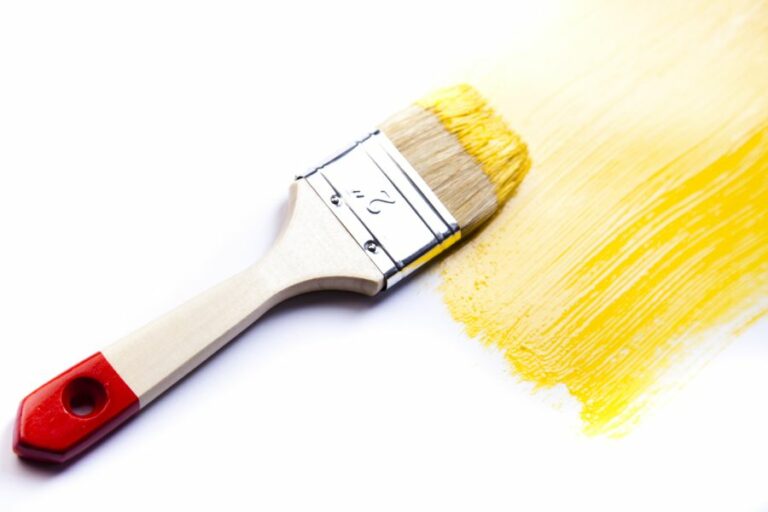Non-Toxic Acrylic Wall Paint Options, 25 Things You Should Know
Are you tired of traditional wall paints’ strong, unpleasant odors and worrying about their health implications? Look no further; I have extensive knowledge of non-toxic acrylic wall paint options that will help transform your space into a vibrant and healthy environment.
Non-toxic acrylic wall paint options:
Non-toxic acrylic wall paints are eco-friendly, water-based without harmful chemicals like VOCs, lead, ammonia, or formaldehyde. Top options include Benjamin Moore Natura, ECOS Paints, and AFM Safecoat. These paints provide a healthier choice for living spaces and are ideal for those with allergies or chemical sensitivities.

Discover the benefits of non-toxic acrylic wall paint options that are safe for you and the environment! Dive into our comprehensive guide on the best brands, applications, and tips for a healthier and eco-conscious painting experience. Don’t miss out. Read on for more!
Contents
- 1 Eco-Friendly Acrylic Wall Paint Choices
- 2 Discover the Most Secure Acrylic Paints
- 3 Acrylic Paint: Is it Harmless?
- 4 Using Acrylic Paint Indoors: Safety Concerns
- 5 VOC-Free Acrylic Paint: Facts and Benefits
Eco-Friendly Acrylic Wall Paint Choices
As a seasoned painting professional who has worked with various wall paints, I highly recommend using non-toxic acrylic wall paint options for residential and commercial painting projects.
• What Defines a Non-Toxic Acrylic Wall Paint?
Non-toxic acrylic wall paints are water-based paints that do not have harmful chemicals like volatile organic compounds (VOCs), lead, ammonia, or formaldehyde.
These eco-friendly options are safer for the environment and human health, making them a popular choice for many professionals and property owners.
– The Importance of Low or Zero VOCs
A key aspect of non-toxic acrylic wall paint is that it typically contains low or zero VOC levels. VOCs are harmful chemicals that can evaporate into the air as the paint dries, causing respiratory issues, allergies, headaches, and more long-term.
Low or zero-VOC paints are a healthier choice, especially for individuals with existing health conditions, babies, and young children.
• Top Non-Toxic Acrylic Wall Paint Options
Here is a list of non-toxic acrylic wall paint options that I personally recommend:
1. Benjamin Moore Natura
One of my favorite choices for residential and commercial paint jobs, Benjamin Moore’s Natura line, is a zero-VOC, acrylic-based paint. It offers excellent coverage and comes in a wide range of colors, making it easy to find the perfect match for any room.
Here is a link to help you better understand the role of VOCs on indoor air quality.
2. ECOS Paints
ECOS paints is well-known for its commitment to offering environmentally friendly and non-toxic paint products. Their line of wall paints is no exception, with a complete selection of zero-VOC and low-odor options.
Apart from being non-toxic, ECOS Paints are also known for their durability and easy application.
3. AFM Safecoat
AFM Safecoat offers a variety of wall paint options, including zero-VOC and low-VOC acrylic paints. They are also known for their commitment to eliminating harmful chemicals and providing allergy-friendly products.
Safecoat paints are an excellent choice for individuals with chemical sensitivities or those looking to create a healthier indoor environment.
• Tips for Applying and Choosing Non-Toxic Acrylic Wall Paints
1. Prioritize the Surface Preparation
As with any paint project, surface preparation is key to ensuring a smooth and long-lasting finish. Clean the walls thoroughly to remove dust, dirt, and grease before applying any paint.
If repainting over old paint, make sure the surface is free of peeling, cracking, or chipping paint. Proper priming is essential for optimal adhesion and coverage.
2. Consider the Sheen Level
Non-toxic acrylic wall paints come in various sheen levels, from matte to high-gloss. The choice of sheen level depends on personal preference and the room’s usage.
High-traffic areas like hallways and children’s rooms may benefit from a more durable, semi-gloss sheen while living rooms and bedrooms can opt for a matte or eggshell finish.
3. Schedule Painting during Favorable Weather Conditions
Proper ventilation is essential when applying wall paint to avoid any remaining paint odor. Try to plan your painting project during warmer and less humid days when you can comfortably open windows for optimal airflow.
4. Practice Safe Painting Techniques
Even though non-toxic acrylic wall paints are safer than their conventional counterparts, always follow safe painting practices like wearing gloves, using a mask, and ensuring proper ventilation. Follow the manufacturer’s instructions on paint application and drying times.
In conclusion, non-toxic acrylic wall paints are an excellent option for creating a healthier living or working environment while maintaining a professional and aesthetically pleasing finish.
By choosing one of the recommended paint options and following the given tips, you can confidently embark on your next painting project with the knowledge that you are contributing to a better environment for everyone.
Discover the Most Secure Acrylic Paints
Creating beautiful works of art can be an enjoyable and fulfilling hobby for people of all ages. However, when working with paints, it is important to ensure that the materials used are safe for both the artist and the environment.
One popular and versatile type of paint is acrylic, which is known for its quick drying time and ability to adhere to various surfaces.
• Understanding Acrylic Paint Safety
When discussing acrylic paint safety, the main concern is often the presence of harmful chemicals and substances. These may include lead, cadmium, and other heavy metals, as well as solvents and volatile organic compounds (VOCs).
Exposure to these substances can lead to a variety of health issues, from skin irritation to more serious conditions such as neurological damage or cancer. Additionally, improper disposal of paint containing these chemicals can result in environmental harm.
To minimize exposure to toxic substances, many artists choose to seek out non-toxic or low-toxicity acrylic paints. These types of paint typically contain fewer potentially harmful ingredients and are safer for both users and the environment.
To determine the safety of a specific acrylic paint, it is essential to check the label for key information such as the ingredients list and any safety warnings.
Here is a list of some of the safest acrylic paints available, based on their non-toxic or low-toxicity formulations.
– Liquitex BASICS Acrylic Paint
Liquitex has long been a trusted brand in the realm of acrylic paints, known for its high-quality products. The company’s BASICS Acrylic Paint line is an especially safe option as it is certified as non-toxic by the Art & Creative Materials Institute (ACMI).
This means that the paint has been tested for potential hazards and found to contain no materials in sufficient quantities to be toxic or injurious to humans or the environment. The Liquitex BASICS range includes a wide variety of colors and is an excellent choice for both novice and experienced artists.
– Golden Artist Colors Acrylics
Another reputable brand in the acrylic paint industry is Golden Artist Colors. Their acrylic paints are known for their high pigment load and buttery consistency, making them a favorite among artists. Golden Artist Colors acrylic paints are also ACMI-certified non-toxic, ensuring their safety for use.
You can learn more about their paint formulations and commitment to safety on the Golden Artist Colors website.
– Chroma Atelier Interactive Acrylics
Chroma Atelier Interactive Acrylics offer a unique feature in that they can be “re-wetted,” allowing artists more control over the drying process. This feature is particularly useful for those working on large or complex projects that require significant time investment.
Additionally, Chroma Atelier Interactive Acrylics are formulated with minimal amounts of additives, resulting in a safer and more environmentally-friendly product. They are also certified as non-toxic by the ACMI.
– Winsor & Newton Galeria Acrylics
Winsor & Newton is known for its high-quality art supplies, and their Galeria Acrylics are no exception. This affordable range of acrylic paints is designed for artists seeking a professional-grade product without the hefty price tag.
Galeria Acrylics are formulated to meet the same stringent safety standards as other Winsor & Newton products and have been certified as non-toxic by the ACMI.
• Factors to Consider When Choosing Safe Acrylic Paint
When selecting the safest acrylic paint for your needs, it is essential to consider certain factors that will affect both the quality and suitability of the paint. Some of these factors include:
- Toxicity: As mentioned earlier, the primary consideration when choosing safe acrylic paint is the presence of harmful chemicals and substances. Opting for non-toxic or low-toxicity acrylic paints will help minimize exposure to these hazards.
- Quality: The quality of acrylic paint is determined by its pigment load, consistency, and other factors. High-quality paints will typically offer better coverage, color vibrancy, and overall performance. Look for reputable brands that have a proven track record of producing top-quality acrylic paints.
- Price: While price should not be the sole determinant in choosing safe acrylic paint, it is essential to find an option that meets both your budget and quality requirements. Fortunately, many non-toxic acrylic paints are available at various price points, making it possible to find an affordable and safe product that suits your needs.
- Environmental impact: Another aspect to consider when selecting acrylic paint is the environmental impact of the product. Choosing water-based acrylic paints with minimal additives and VOCs will help minimize the ecological footprint of your artwork.
• Final Thoughts on Safest Acrylic Paints
Ultimately, the safest acrylic paints are those that meet stringent safety standards, have minimal hazardous ingredients, and come from reputable manufacturers.
Brands such as Liquitex, Golden Artist Colors, Chroma Atelier, and Winsor & Newton offer a range of non-toxic or low-toxicity acrylic paints that are suitable for a variety of artistic applications.
By researching and selecting safe, high-quality acrylic paints, you can help protect both your health and the environment while enjoying the beautiful world of art.
Rank | Brand | Description |
|---|---|---|
1 | Golden Artist Colors | Golden produces acrylic paints that are known for their high-quality and safety, with non-toxic formulas and rigorous testing for harmful substances. |
2 | Liquitex | Liquitex creates a range of professional-grade acrylic paints that are safe to use, free from toxic chemicals, and compliant with ASTM D-4236 safety standards. |
3 | Winsor & Newton | Winsor & Newton offers a selection of non-toxic, water-based acrylic paints that meet safety standards in terms of their composition and labeling. |
4 | Chroma Atelier | Chroma Atelier produces high-quality acrylic paints that comply with safety standards, ensuring that their products are safe for artists to use. |
5 | Arteza | Arteza is known for its budget-friendly, non-toxic acrylic paints that don’t compromise on safety or quality, making them a great choice for artists of all levels. |
Acrylic Paint: Is it Harmless?
• Understanding Acrylic Paint
Acrylic paint is a versatile and popular painting medium, known for its vibrant colors, quick drying time, and easy clean-up. It consists of pigment suspended in an acrylic polymer emulsion, which gives the paint its unique properties.
Before diving into the question of whether acrylic paint is non-toxic, it’s important to understand the various ingredients used in its composition.
– Pigments
Pigments give acrylic paint its color, and can be derived from various sources, including organic and inorganic materials. Some pigments are non-toxic, such as those derived from plants or synthetic sources.
However, certain pigments, like cadmium or cobalt, are toxic and can pose health risks if ingested or inhaled. It is essential to handle these pigments with caution and use proper safety measures, such as gloves and masks, when working with them.
– Acrylic Polymer Emulsion
The acrylic polymer emulsion is the “glue” that binds the pigment particles together and adheres them to the painting surface. This emulsion is made from a polymer, which is a long-chain molecule derived from chemical reactions.
Generally, the polymer used in acrylic paint is non-toxic and poses minimal health risks. However, it’s important to note that some emulsions may contain small amounts of toxic chemicals, such as ammonia or formaldehyde, to prevent bacterial or fungal growth.
– Additives
Some acrylic paints contain additives to modify the paint’s properties, such as its thickness, drying time, or sheen. These additives can include non-toxic materials like cellulose or other natural polymers.
However, some additives may contain harmful substances, like solvents or biocides, which can pose health risks if inhaled or ingested.
• Evaluating the Safety of Acrylic Paint
– Manufacturer’s Safety Information
To determine whether a specific brand or type of acrylic paint is non-toxic, it’s important to consult the manufacturer’s safety data. This information can be found on the paint label or on the manufacturer’s website.
Non-toxic paints should be labeled as such, and often carry the certification of the Art and Creative Materials Institute (ACMI). ACMI-certified paints are evaluated to meet strict standards for toxicity, and are deemed safe for use by artists of all ages.
Alternatively, you can look for the “AP” (Approved Product) seal on the paint label, which indicates that the product has been reviewed and deemed safe according to ACMI standards.
– Inhalation and Ingestion Risks
While most acrylic paints are considered non-toxic, it’s still important to exercise caution when using these materials. Regardless of the paint’s certified safety, handling any paint can pose some level of risk, particularly through inhalation or ingestion.
When working with acrylic paint, it’s recommended to use proper ventilation, especially if working in an enclosed space or for extended periods of time. This can help minimize the risk of inhaling any vapors or particles that may be released during the painting process.
Additionally, it’s essential to avoid ingesting acrylic paint. While many paints are considered non-toxic, ingesting any type of paint can be harmful to your health. To minimize this risk, wash your hands thoroughly after working with paint and avoid eating or drinking in your painting area.
• Tips for Safe Acrylic Paint Use
To ensure the safest possible painting experience, consider the following tips and recommendations:
- Choose non-toxic paints: Opt for acrylic paints labeled as non-toxic or carrying the ACMI AP seal. These paints meet stringent safety standards and are less likely to pose health risks.
- Use proper ventilation: Ensure your painting area has adequate ventilation, either through open windows or an exhaust fan. This helps minimize the risk of inhaling paint particles or fumes.
- Wear protective gear: Use gloves and masks when working with potentially toxic pigments or additives. This can help reduce the risk of skin contact or inhalation.
- Clean up thoroughly: Wash your hands, brushes, and painting surfaces after use to minimize the risk of ingesting paint particles.
- Follow manufacturer’s safety guidelines: Consult the manufacturer’s safety information to ensure you are using your acrylic paints correctly and safely.
In conclusion, acrylic paint can be considered non-toxic when used appropriately and when selecting products labeled as such. However, it’s essential to always exercise caution and follow safety guidelines to minimize potential health risks. Happy painting!
Using Acrylic Paint Indoors: Safety Concerns
Acrylic paint is a popular medium for artists and DIY enthusiasts alike, and many people work with it indoors. However, this begs the question: is it safe to use acrylic paint indoors?
The answer to this question is multifaceted and depends on several factors, including the quality of the paint, proper ventilation, and following safety precautions.
• Understanding Acrylic Paint Ingredients
To determine the safety of using acrylic paint indoors, it’s crucial to understand its composition. Acrylic paints are water-based and made of a combination of pigments, acrylic resin, and other additives.
Most acrylic paints available on the market are non-toxic, as they do not contain harmful chemicals like lead, cadmium, or other hazardous materials.
It’s essential to choose high-quality acrylic paints from reputable manufacturers, as they often have better safety standards and use non-toxic ingredients.
When shopping for acrylic paint, always check the label for safety information and look for products that bear the AP (Approved Product) seal from the Art and Creative Materials Institute (ACMI).
• Proper Ventilation for Indoor Painting
Although most acrylic paints are non-toxic, they can still produce fumes, particularly when used in large quantities or over an extended period. These fumes can cause headaches, dizziness, and irritation, especially for individuals with asthma or other respiratory issues.
To minimize the risks associated with fumes, always ensure proper ventilation when using acrylic paint indoors. Open windows and doors to promote airflow, and use an air purifier or exhaust fan if available. Take frequent breaks and step away from the painting area if you experience any discomfort.
• Using Personal Protective Equipment
Even though acrylic paint is generally safe to use indoors, it’s crucial to protect yourself by wearing appropriate personal protective equipment (PPE). The following PPE can be helpful when working with acrylic paint:
- Gloves: Wearing gloves can prevent skin irritation and help keep your hands clean. Choose gloves made of nitrile or another non-latex material, as some people may have a latex allergy.
- Goggles: If you’re working with large amounts of paint or using techniques that may cause splashes, wearing goggles can help protect your eyes from potential irritation or injury.
- Aprons or protective clothing: Acrylic paint can be difficult to remove from clothing once dry, so it’s a good idea to wear an apron or clothing you don’t mind getting dirty.
• Safe Storage and Disposal of Acrylic Paint
To safely use acrylic paint indoors, it’s important to store and dispose of it properly. Follow these tips for effective storage and disposal:
- Store paint in a cool, dry area away from sunlight and out of reach of children and pets.
- Dispose of empty paint containers and materials in accordance with your local waste management regulations. Do not pour leftover paint down the drain, as it can cause environmental pollution once it reaches waterways.
- Clean brushes, palettes, and other tools promptly after use with soap and water to prevent the paint from drying and becoming difficult to remove.
• Final Thoughts on Using Acrylic Paint Indoors
In conclusion, it is generally safe to use acrylic paint indoors if you choose high-quality, non-toxic products and follow proper safety precautions.
By ensuring adequate ventilation, using personal protective equipment, and practicing safe storage and disposal methods, you can minimize potential risks and enjoy the creative process of using acrylic paint.
Remember that if you ever experience discomfort or respiratory issues while painting indoors, it’s crucial to take a break, step outside for fresh air, and consult with a healthcare professional if necessary. Happy painting!
VOC-Free Acrylic Paint: Facts and Benefits
Acrylic paint is a versatile and popular medium, with applications ranging from fine art to home decor. One significant advantage of acrylic paint is that it is generally safer for the environment and our health compared to other types of paint.
A valid concern for many artists and consumers is whether or not acrylic paint is free of volatile organic compounds (VOCs).
• What are VOCs?
Volatile organic compounds (VOCs) are carbon-containing chemicals that easily evaporate at room temperature.
These compounds can be found in numerous everyday products, such as cleaning agents, air fresheners, and even certain types of paint. VOCs are of concern due to their potential adverse effects on human health and the environment.
Exposure to high levels of VOCs can cause headaches, dizziness, respiratory problems, and even long-term damage to vital organs, according to the United States Environmental Protection Agency.
• Acrylic Paint Composition
To better understand whether acrylic paint is free from VOCs, we must first examine its composition. Acrylic paint primarily consists of pigment (color) suspended in an acrylic polymer emulsion. The polymer emulsion is a clear liquid that contains tiny solid particles, which form a film when the paint dries.
In addition to the pigment and acrylic polymer, additives may be present to improve the paint’s performance, such as drying agents and flow improvers.
• Is Acrylic Paint VOC Free?
In general, most acrylic paints are considered to be low in VOCs compared to other types of paint, such as oil-based or alkyd paints. This is because the polymer emulsion in acrylic paint does not typically contain organic solvents that could release significant levels of VOCs during the drying process.
However, it is crucial to note that not all acrylic paints are created equal. Some may contain additives that release VOCs or other potentially harmful substances. Therefore, it is essential to check the paint’s label for any warnings or certifications, such as the Arts and Creative Materials Institute (ACMI)
Approved Product (AP) Seal, which indicates that the product has been evaluated and found to contain minimal levels of potentially harmful substances, including VOCs.
• Healthier Alternatives
For those concerned about VOCs in acrylic paints, there are healthier alternatives on the market. Here are some recommendations to consider:
- Water-based paints: Water-based paints, also known as latex paints, have a lower VOC content than oil-based or alkyd paints. They are generally easier to clean up and are less likely to cause respiratory issues.
- Low VOC or VOC-free paints: Some paint manufacturers explicitly offer low VOC or VOC-free acrylic paints. These products have been formulated to minimize the presence of VOCs and other harmful substances, providing a more environmentally-friendly option.
- Natural pigments: Opting for paints made with natural pigments, such as earth or mineral-based pigments, can also help reduce exposure to VOCs. Natural pigments tend to have a lower environmental impact and pose fewer health risks than synthetic alternatives.
• Additional Precautions
Even when using acrylic paints with minimal VOC content, it is always a good idea to take certain precautions when working with these products. The following safety measures can help reduce exposure to VOCs and other substances present in acrylic paints:
- Work in a well-ventilated area: Ensuring proper ventilation in your workspace can help disperse the fumes released by the paint, lowering the risk of inhaling harmful substances.
- Wear safety gear: Wearing a mask designed to filter organic vapors, as well as gloves and protective clothing, can help minimize direct contact with potentially hazardous materials.
- Store and dispose of paints properly: Following the manufacturer’s instructions for storage and disposal will ensure that paints do not release harmful substances into the air over time.
- Take regular breaks: Limiting the amount of time spent working with paints can help reduce overall exposure to VOCs and other chemicals.
In conclusion, while most acrylic paints are considered low in VOC content, it is essential to remain informed about the specific paint products being used and take necessary precautions to protect one’s health and the environment.
By opting for healthier paint alternatives and adhering to recommended safety practices, artists and consumers can continue to enjoy the versatility of acrylic paint with minimal concern for VOC exposure.







